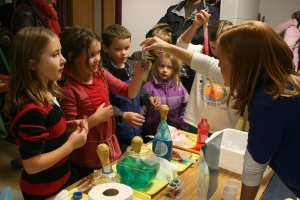Children's Learning Styles
Newborns enter a world filled with sights, sounds, and sensations. These auditory, visual, and tactile stimuli are received by highly specialized receptors in a baby’s ears, eyes, and skin. Children reveal their preference for a particular way of learning in the first few months of life.
I refer to the three basic types of learners as Listeners, Lookers, and Movers. As babies, Listeners are attuned to sounds and words. They talk early, rapidly add words to their vocabulary, and enjoy being read to.
From the first year of life, Lookers are drawn to color, shape, and motion. Their eye-hand coordination is excellent, and as toddlers they enjoy playing with blocks, stringing beads, and doing simple puzzles. As infants Movers achieve motor milestones, such as crawling and walking, ahead of schedule. They are well coordinated and confident in their bodies. Movers crave to be held and rocked, and they seek out physical contact.
Learning Style is Inborn
Learning style can be observed so early on because it’s inborn and inherited. A baby’s learning style tends to be like that of one parent or a blend of both. Sometimes, a child’s learning style is like that of a close relative such as an uncle or grandparent.
You can see evidence of hereditary factors when you catch yourself thinking, “Golly, he’s exactly like his uncle Jack” when, as a toddler, your son pulls away from being touched, or as a first grader, excels in math but struggles with reading.
The School Years
If learning style is not influenced by the adults in a child’s life, over time children tend to settle into a preferred way of learning. In fact, in their attempts to achieve a comfort zone, children may screen out less favored types of information.
When this occurs, by first grade a Looker may have difficulty mastering phonics, a Listener may be unable to memorize math facts on flash cards, and a Mover may be up and out of his seat during classroom instruction.
Learning preferences are easy to spot in Mrs. Lively’s first grade classroom. There’s Meredith who's talkative in class and everywhere else. She loves to read aloud and is in the best reading group. She frequently talks to herself when doing seat work and gets in trouble for passing notes to girlfriends.
Her favorite pastimes include listening to the radio and to her tape player which she takes with her on trips in the car. She likes games such as “Mother, May I?” Without a doubt, Meredith is a Listener.
Also a first grader, Brett is quiet, and even when he knows the answer, rarely volunteers to speak in class. His favorite pastimes include computer games and putting together model airplanes.
Brett’s math pages are near perfect, and he is precise about forming letters and staying within the lines. Brett, of course, is a Looker.
When called upon by his first grade teacher, Ethan responds with short unelaborated sentences, his favorite being “I dunno.” He isn’t really himself until the school bell rings. Well coordinated and naturally competitive, he comes alive on the playground. In class, Ethan feels confined at a desk. He struggles to print on lined paper and displays some letter reversals. Ethan is a Mover.
Rather than “outgrow” their preferences for learning in a particular way, as children move through the grades, they tend to get more crystallized in a particular way of learning. Eventually, this will limit their options in terms of learning.
How Parents Can Help
Parents can maximize learning ability by identifying their child’s learning style beginning as early as the first year of life. With this information they're ready to develop a strategy for playing with their child.
This means that they choose toys, games, and activities both to affirm a particular learning strength and to develop areas needing support. By playing in an intentional way, parents can open up possibilities for their child helping him or her to become a more balanced and confident learner.
How to Maximize Your Child's Learning Ability: A Complete Guide to Choosing and Using the Best Computer Games
by Dr. Lauren Bradway
The authors' intent is to help parents determine a child's learning style and use this knowledge both to strengthen natural abilities and to develop skills that might be lagging.
About the Author:
Dr. Lauren Bradway has a Master's Degree in Communication Disorders and a Ph.D. in Human Ecology. Dr. Bradway has specialized in working with children for over 20 years. In addition to running a successful clinical practice as a speech language pathologist, she is a consultant to pre-schools, elementary schools, and bilingual programs. She trains teachers to develop Individual Learning Style Profiles for classroom use.






